

Recursos digitales para el estudio de la Poesía Medieval Castellana. Catalogue - OpenEdition Books. Jean-Pierre Brun, Thomas Faucher, Bérangère Redon et al.
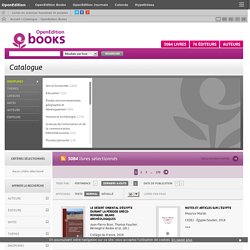
Manifeste des Digital humanities – THATCamp Paris. Contexte Nous, acteurs ou observateurs des digital humanities (humanités numériques) nous sommes réunis à Paris lors du THATCamp des 18 et 19 mai 2010.

Au cours de ces deux journées, nous avons discuté, échangé, réfléchi ensemble à ce que sont les digital humanities et tenté d’imaginer et d’inventer ce qu’elles pourraient devenir. À l’issue de ces deux jours qui ne sont qu’une étape, nous proposons aux communautés de recherche et à tous ceux qui participent à la création, à l’édition, à la valorisation ou à la conservation des savoirs un manifeste des digital humanities. I. About GrinUGR. La denominación GrinUGR proviene de “GRupo de INternet de la Universidad de GRanada”, un sintagma que el proceloso mundo de la tecnología y su impacto social ha ido superando, en un constante proceso de redefinición.

Red Internacional de Estudios Digitales sobre la Cultura Artística. Ana Isabel Fernández Moreno (Universidad de Granada)
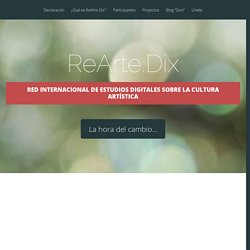
Laboratorio de Investigación de Humanidades Digitales. Presentación - Humanidades Digitales Hispánicas. About GrinUGR. 2016. Managing 100 Digital Humanities Projects: Digital Scholarship & Archiving in King’s Digital Lab James Smithies, King's College London; Carina Westling, King's College London; Anna-Maria Sichani, King's College London; Pam Mellen, King's College London; Arianna Ciula, King's College London Modelling Medieval Hands: Practical OCR for Caroline Minuscule Brandon W.
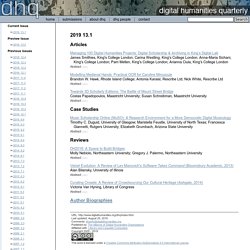
Hawk, Rhode Island College; Antonia Karaisl, Rescribe Ltd; Nick White, Rescribe Ltd Towards 3D Scholarly Editions: The Battle of Mount Street Bridge. Day of DH 2016 – Day of Digital Humanities 2016. CenterNet. ArtyHum Monografico HD. Infinite E-Lit: A Look from Hispanic Legacies. This is the abstract of the talk I will be giving at the Hall Center for Humanities at KU as part of the Digital Humanities Seminar on March 25th.
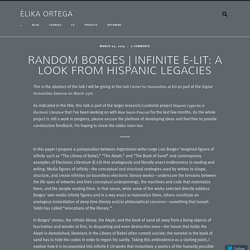
As indicated in the title, this talk is part of the larger research/curatorial project Hispanic Legacies in Electronic Literature that I’ve been working on with Alex Saum-Pascual for the last few months. As the whole project is still a work in progress, please excuse the plethora of developing ideas and feel free to provide constructive feedback. I’m hoping to share the slides soon too. In this paper I propose a juxtaposition between Argentinian writer Jorge Luis Borges’ imagined figures of infinity such as “The Library of Babel,” “The Aleph,” and “The Book of Sand” and contemporary examples of Electronic Literature (E-Lit) that analogously and literally enact endlessness in reading and writing. Mark Sample Joins ELO Board. Pathfinders. Vispo ~ Langu(im)age: interactive, visual, and sound poetry by Jim Andrews. “Enigma n” and “Seattle Drift” by Jim Andrews: The Cauldron & Net Editions – I ♥ E-Poetry.
When Jim Andrews published these poems in Cauldron& Net, Volume 1 in 1999, their original DHTML and JavaScript codes were compatible with the two main Web browsers of their time: Netscape Navigator 4 and Internet Explorer 4 (IE).
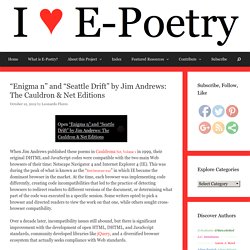
This was during the peak of what is known as the “first browser war” in which IE became the dominant browser in the market. At the time, each browser was implementing code differently, creating code incompatibilities that led to the practice of detecting browsers to redirect readers to different versions of the document, or determining what part of the code was executed in a specific session. Some writers opted to pick a browser and directed readers to view the work on that one, while others sought cross-browser compatibility. Enigma n home page.
Enigma n 1998, by Jim Andrews.
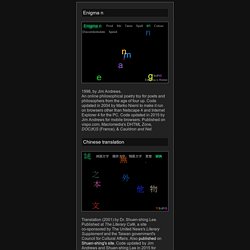
An online philosophical poetry toy for poets and philosophers from the age of four up. Electronic Literature and Its Emerging Forms. Talan Memmott is a Lecturer in Digital Culture at Blekinge Institute of Technology in Sweden.

He holds an MFA in Literary Arts/Electronic Writing from Brown University and a PhD in Interaction Design from Malmö University. Memmott is a practicing artist, an academic, and a media theorist. His creative work has been presented at numerous conferences and festivals, and been the subject of a number of critical articles and books. Memmott is Vice President of the Electronic Literature Organization, the Coordinator of the Nordic Digital Culture Network, and 2010-2013 was a researcher on the ELMCIP European research project.
To learn more about Talan’s work, visit: talanmemmott.com About “Lexia to Perplexia” Lexia to Perplexia is a deconstructive/grammatological examination of the “delivery machine” with its text falling into the gaps between theory and fiction. Talan Memmott. Reading by Talan Memmott. On Thursday evening Feb 17th, in HF 301 from 5-6:30PM, visiting research and artist Talan Memmott will show and discuss some of his creative work including electronic literature and video work.
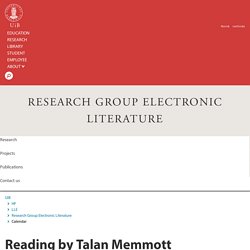
Talan Memmott is Assistant Professor / adjunkt in the Literature, Culture & Digital Media program at Blekinge Tekniska Högskola in Karlskrona, Sweden, and is both a researcher and an artist. He holds an M.F.A. in Electronic Writing, Brown University. He has written and created many influential works and is deeply involved in the field of electronic literature. Reading by Talan Memmott. Forest ambassador. Bite-Sized Horror Games: funny, scary interactive fiction. Sub-Q Magazine - Interactive fiction lives here. Top games tagged Twine - itch.io. The Interactive Fiction Database - IF and Text Adventures. My Father's Long, Long Legs. © 2015 by michael lutz | Originally published at Correlated Contents, August 2013, August 2013.
Reprinted with permission. | Cover Art © 2015 Cover photo by Jessamyn West. Used with permission. A tall tale. A young girl's father starts digging in the basement... and never stops. Letters. Galatea - Parchment. Photopia - Parchment. Aisle - Parchment. How to make a Twitter Bot with Google Spreadsheets (version 0.4) – Zach Whalen. Do you like Twitter bots? I know I sure do.
I like following them, and I like making them. I also like introducing my students to bots as one way to do creative things in a networked digital context. That’s way, back in 2013, I cobbled together a simple tool built on a Google Spreadsheets that lets anyone create a simple bot without having to write any code.
There are many other ways to make a Twitter Bot, but I like this approach for its clarity and hopefully its accessibility for non-programmers to start understanding how to think about language through programming. Today, I’m releasing an upgraded and much improved version of that tool. Some Caveats. Generated Detective #1. Generated Detective #1 by Greg Borenstein. You Must Be. Advanced Natural Language Generation Software. GitHub - dariusk/NaNoGenMo-2015: National Novel Generation Month, 2015 edition.
How Machines Write Poetry. As a teenager in Vermont, Sarah Harmon used Java to create a computer program that wrote poetry. She named it OGDEN. Then she submitted one of its poems in 2008 to her high-school literary magazine under the pen name Dan Goshen, an anagram of Ogden Nash. “They accepted it,” Harmon laughs, “although they did say all these funny things about how abstract it was.” OGDEN was nothing fancy, she says. It followed predefined rules of grammar and structure to compose poetical-sounding snippets. These days, Harmon is a computer science PhD student at the University of California, Santa Cruz.
Researchers can’t even agree on what creativity is. Image: Shutterstock One of the first computer bards was named Racter. Eliza. Electronic Literature as a Model of Creativity and Innovation in Practice. Electronic Literature Organization. DAKOTA. THE STRUGGLE CONTINUES! (DANCE VERSION) Randomwalk. A House of Dust. House of Dust by Alison Knowles and James Tenney. Creative Works. Electronic Literature Collection Volume One. Network Effect. The Whale Hunt / A storytelling experiment / by Jonathan Harris. I ♥ E-Poetry – Short-form scholarship on born-digital poetry and poetics. 'my body' - a Wunderkammer & (Shelley Jackson) Uncle Roger by Judy Malloy. Eastgate: Serious Hypertext. Sea and Spar Between. Hatnote Listen to Wikipedia. Throw in at the deep end. English[edit] Etymology[edit] From allusion to an actual swimming pool.
Verb[edit] throw in at the deep end. Dreaming Methods - A fusion of writing and new media - The Flat. Immersive storytelling between gaming and narrative: interview with Andy Campbell. New forms of immersive storytelling are becoming more and more popular, featuring transmedia components and merging narrative modules with gaming elements, as video games’ technology has been particularly influential in the development of these new narrative forms. Specifically, storytelling is getting more immersive and participative, in the sense that audience is engaged in a more interactive way and the environment is evolving into a more complex transmedia scenario.
Perfect examples of this new immersive narrative form are the most recent works of Andy Campbell. One of them, Pluto, created by Andy Campbell together with Australian digital artist Mez Breeze, has just been awarded with The Space Open Call and Tumblr International Price 2015. Pluto is a transmedia work featuring immersive video game elements and digital storytelling; as per the artists’ words, it is a: “storyworld where perceptions are stretched beyond the ‘real’ as you [think you] know it”. Digital poet builds world’s largest science fiction game - Scimex. From QUT It's X Files meets HP Lovecraft - an interactive science fiction whodunit on a digital canvas that was itself considered science fiction only five years ago. Brisbane-based digital poet Jason Nelson has created one of the world's first - and certainly the biggest - speculative fiction games ever built for large, public touchscreen displays as part of his digital writing residency at Queensland University of Technology (QUT).
Part video game, part puzzle, part electronic literature and all-interactive, Cryptext invites you to uncover the details behind a secret government program building advanced alien and supernatural technologies. And it can be played only on the world's largest interactive, digital display space, QUT's The Cube. Graphoem. Jason Nelson- Digital Art and Poetry Wonderments and Creatures. Between Play and Politics: Dysfunctionality in Digital Art.
Let me jump right into the heart of my topic, by presenting two examples. The first, Image Fugurator, a project by Julius von Bismarck which won the Prize Ars Electronica 2008 in the category Interactive Art at the Cyberarts Festival in Linz, Austria, inverts the functioning of a regular camera. Whereas in a normal camera the light projected by objects is captured unto film, with Image Fugurator, an image stored on film within the camera is briefly projected onto the external world when the flash goes on. The whole process is triggered when the camera senses other flashes in the vicinity - this is to say, when other people are trying to photograph the same scene. Starwars_one_letter. MIT TechTV – "The Thinking Machine" (1961) - MIT Centennial Film. Gingerbeardman. 253 - interactive novel home. Electronic Literature. Electronic Literature is an emergent literary form and academic field, whose genesis in the U.S. can be traced, as mentioned elsewhere on this website, to the work by Michael Joyce, afternoon: a story.
As a form, it can be described as "literary works created with the use of a computer for the electronic medium such that they cannot be experienced in any meaningful way without the mediation of an electronic device" (Grigar, "The Present [Future] of Electronic Literature," 128-9); as a field, it is building through online journals and sites, like Hyperrhiz, ebr, Hermaneia, the Iowa Review Web, Leonardo Electronic Almanac, Turbulence, Drunken Boat, and Authoring Software; a growing body of print publications like N.
While in Europe the term "Digital Literature" is used to refer to Electronic Literature, in the U.S. digital literature is generally seen as print-based literary work digitalized for the web and stand-alone technologies like a CD-ROM. "The 24-Hr.